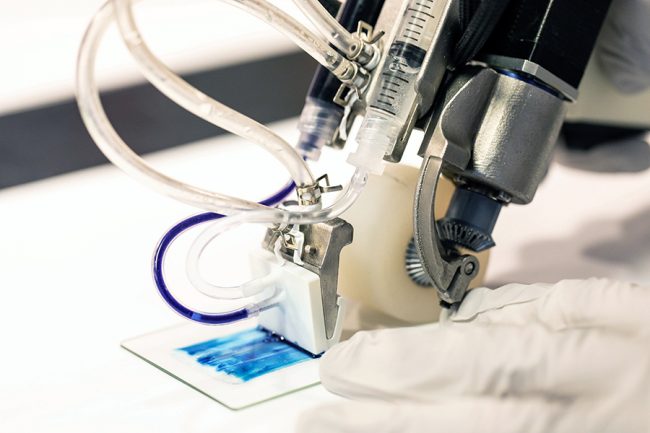
Researchers have recently developed a handheld 3D printer that can print layers of skin to cover burn wounds. The bioink used in this process could potentially speed up the healing process as well. This technology was developed by a research group from the University of Toronto Engineering and Sunnybrook Hospital and the successful in-vivo trials involving it were covered in the journal Biofabrication.
This 3D printer’s bioink is comprised of stem cells that form specialized cell types depending on their environment, known as mesenchymal stroma cells (MSCs). These unique stem cells were utilized in this project to take the form of skin cells, promoting the regeneration of healthy tissue and reducing scar formation.
Led by PhD candidate Richard Cheng under Professor Axel Guenther’s supervision, this project has potentially huge implications for regenerative medicine. Collaboration was provided by Dr. Marc Jeschke, director of the Ross Tilley Burn Centre, and his colleagues at Sunnybrook Hospital.
This research team released the first prototype of this 3D printer in 2018 and believes that this is the first device that can generate tissue in situ. The technology does so in a convenient manner as well, completing the process in under two minutes.
“Previously, we proved that we could deposit cells onto a burn, but there wasn’t any proof that there were any wound-healing benefits — now we’ve demonstrated that,” explained Guenther.
This practical solution to burn care poses great advantages compared to the current autologous skin grafting treatment which involves the transplantation of healthy skin from other areas of the body onto the wound site. By potentially eliminating the need for this procedure, 3D bioprinting could spare burn victims of the burdensome skin grafting procedure.
The researchers note that although the skin grafting procedure is effective, it is less applicable to large burns that cover a greater proportion of the patient’s body. Full-thickness burns pose a similar issue, being defined as burns that damage both the outer and inner layers of the skin.
“With big burns, you don’t have sufficient healthy skin available, which could lead to patient deaths,” noted Jeschke.
The team’s printer has undergone 10 redesigns since 2018, with the end goal being a device that can be used in the operating room. The current version of the technology uses a single-use microfluidic printhead to keep the device sterile. It is also equipped with a soft wheel that follows this printhead’s track, improving the 3D printer’s control for use on larger wounds.
Going forward, Cheng’s goal is to “further reduce the amount of scarring, on top of helping with wound healing. Our main focus moving forward will be on the in-vivo side.”
“Once it’s used in an operating room, I think this printer will be a game changer in saving lives,” added Jeschke. “With a device like this, it could change the entirety of how we practice burn and trauma care.” Jeschke feels that this device will be used in the clinical setting within the next five years.
Handheld 3D skin printer can heal burn victims in situ https://t.co/lnbTdGxbUp #supplychain #3dprinting #healthcare
— Supercharg3d (@Supercharg3d) February 5, 2020







 © 2025 Mashup Media, LLC, a Formedics Property. All Rights Reserved.
© 2025 Mashup Media, LLC, a Formedics Property. All Rights Reserved.